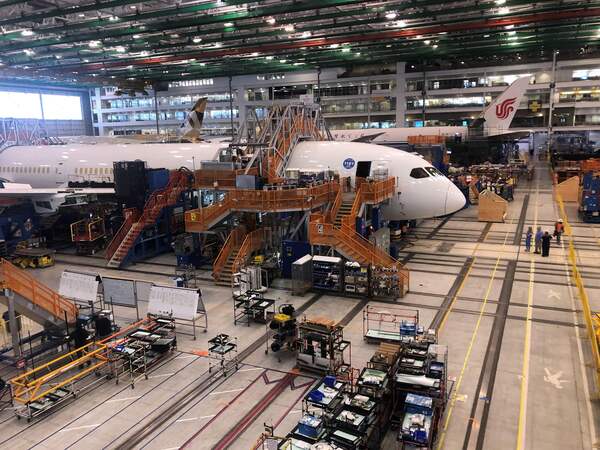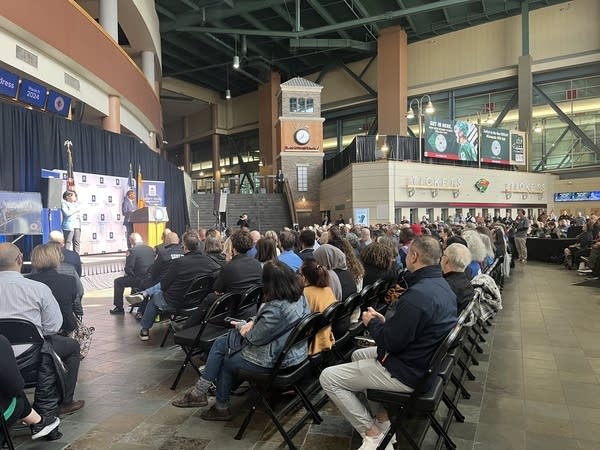
The Twin Cities’ Most Anticipated Spring Restaurant Openings
March 12, 2024
Boeing whistleblower John Barnett, who raised alarm over plane quality, is found dead
March 12, 2024St. Paul Mayor Melvin Carter wants to use the city’s new 1 percent sales tax not just on infrastructure projects, but for job creation and homeownership.
Carter used his annual State of the City address Monday to outline his vision for improving the economic health of residents, as well as prioritizing spending on streets and parks through the tax, which will begin accruing April 1.
In his address to more than 300 gathered at the Xcel Energy Center, Carter shared specifics on that “Common Cent” sales tax initiative. Among his plans: the beautification of the Grand Avenue corridor, the decarbonization of downtown’s heating system and the updating of parking lots, sidewalks, roofs and parks.
Beyond infrastructure improvements, the mayor spoke specifically about creating jobs for residents who have trouble securing employment. That includes youth, people without stable housing and people with disabilities or previous criminal convictions.
“We will set out to minimize the perceived risk associated with betting on the people others have betted against, through forgivable short term business loans to cover up to half of a qualifying employees wages and benefits for a full year,” Carter said.
The city is in the process of working out a pilot program that would create new jobs through partnerships with nonprofits, such as the Autism Society of Minnesota and the daytime shelter, Listening House.
“We are partnering with Listening House to offer zero-barrier job opportunities for residents who have experienced homelessness to help keep our downtown and neighborhood commercial corridors clean,” the mayor said.
To potentially open more opportunities, Carter said he’s ordered the elimination of degree requirements for 90 percent of city job titles. Contracting for infrastructure projects funded by the new 1 percent sales tax will prioritize bidders who employ St. Paul residents. That includes youth in the city’s Right Track program.
Right Track has been around for the past decade, connecting youth from low-income households to internships. Last year, 88 percent of its participants were youth of color, with 82 percent of participants qualifying for free or reduced-price lunch. Around 800 youth got internships last summer.
DeJiohn Brooks, founder of the nonprofit World Youth Connect, currently employs 25 Right Track interns. He’s 24 now, but his story with Right Track started when he was around 17 years old. Being able to get a job with the parks and recreation department as a teen was a turning point for him, he said, after being kicked out of school as a “troubled kid.”
“I was blessed with those internships because they changed my life,” Brooks said, explaining the program helped him land entry-level work. “They take on young people that come from different walks of life.”
Under Carter’s proposal, the estimated $1 billion from the sales tax over two decades also could go toward housing goals.
“We are committed to sustaining those programs designed to facilitate wealth creation through homeownership,” the mayor said, adding his administration will ask the Housing and Redevelopment Authority “to utilize the new metro-wide sales tax to commit $1 million a year in annual funding to down payment assistance like the Inheritance Fund on an ongoing basis.”
New councilmember Anika Bowie, who represents Ward 1, says she’s excited by the additional proposed funding for the city’s Inheritance Fund, which aims to rebuild wealth for low-income families displaced by Interstate 94 construction in the 1960s. Because of that construction, an estimated 700 families in the historically Black Rondo neighborhood lost their homes.
“Especially being a descendant of Rondo, I know the people in my ward are really excited about returning home,” Bowie said. “Now we’re creating a pathway for people to come back and call St. Paul home again.”
The Mayor also outlined a strategy for downtown investments. That included a plan to convert city office spaces to residential housing, invest in more pedestrian-oriented street improvements and invest in redeveloping buildings. He proposed $2 million toward the design of the Xcel Energy Center and Roy Wilkins Auditorium renovations.
He said the city is still identifying funding sources for those downtown investment plans.
“I’m eager to dig into the details” of the residential proposal, said St. Paul City Council President Mitra Jalali.
“If you can actually make sure we have a strong downtown sector, that helps a resident living in Frogtown, that helps the person living on the west side, that helps a Midway homeowner and renter, because we’re all in this shared community together,” Jalali said. “Our downtown tax base just isn’t the same as Minneapolis, and we have a chance to transform that.”
Commissioner Mai Xiong, who sits on the Ramsey County Board for District 6, was one of several elected officials encouraged by the emphasis on lifting up community members.
“On the east side, we have about half of our residents under the age of 35. And very low income too,” Xiong said. “And that’s also where if we double down on our folks, our city will prosper.”
The city could not yet provide an estimate for how much the investment in jobs would cost. Carter’s proposals will be up for discussion in future city meetings.





